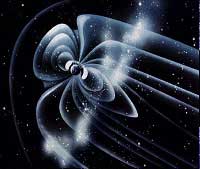| Main Menu > 5: Learning About Risks >Solar Wind |
|
The solar wind has slowly eroded the Martian atmosphere for billions of years—transforming the planet into a barren desert.
That's a puzzle to planetary scientists, because Mars's surface is littered with signs of liquid water. Dried up valley networks, sedimentary deposits, and chaotic flood plains hint that billions of years ago Martian water flowed freely and that the atmosphere there must have been substantially thicker than it is now. But where did all that Martian air go? New evidence from NASA's Mars Global Surveyor (MGS) spacecraft supports a long-held suspicion that much of the Red Planet's atmosphere was simply blown away—by the solar wind. The solar wind is a fast-moving part of the Sun's outer atmosphere. The solar corona, with a temperature greater than one million degrees C, is so hot that the Sun's gravity can't hold it down. It flows away in all directions traveling 400 to 800 km/s. Every planet in the solar system is immersed in this gusty breeze of charged particles. Here on Earth we're protected from the solar wind by a global magnetic field (the same one that causes compass needles to point north). Our planet's magnetosphere, which extends far out into space, deflects solar wind ions before they penetrate to the atmosphere below. Mars isn't so fortunate. Lacking a planet-wide magnetic field, most of the Red Planet is exposed to the full force of the incoming solar wind. "The Martian atmosphere extends hundreds of kilometers above the surface where it's ionized by solar ultraviolet radiation," says Dave Mitchell, a space scientist at the University of California at Berkeley. "The magnetized solar wind simply picks up these ions and sweeps them away." "In 1989 the Soviet Phobos probe made direct measurements of the atmospheric erosion," he continued. When the spacecraft passed through the solar wind wake behind Mars, onboard instruments detected ions that had been stripped from Mars's atmosphere and were flowing downstream with the solar wind. "If we extrapolate those Phobos measurements 4 billion years backwards in time, solar wind erosion can account for most of the planet's lost atmosphere." "To calculate the total loss of atmosphere," he added, "we must take into account how the Sun has changed during the past four billion years. The Sun's ultraviolet output was larger in the past, and the solar wind was probably much stronger. This means that solar wind erosion was likely much more effective in the past than it is today." Although Mars no longer has a substantial magnetosphere, scientists think it once did and that the remnants of it still exist. In 1998 magnetometers on MGS discovered a network of magnetic loops arrayed across Mars's southern hemisphere. Locally, the magnetic fields arch over the surface like umbrellas, hundreds of km high. "If you were standing on Mars in one of these areas," says Mitchell, "you would measure a magnetic field about as strong as Earth's—a few tenths of a gauss." Elsewhere on the planet the magnetic field is 100 to 1000 times weaker. Solar Wind continues in PDF form:
Solar Wind continues on the Web:
|
||||||||||
©2002 UC Regents

